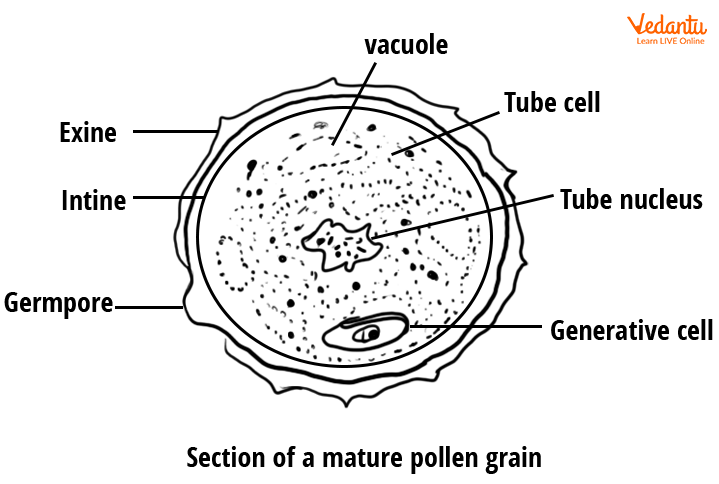MCQ ON Pollen grains for NEET |MCQ ON Pollen grains for NEET Biology class 12 th |MCQ Questions for class 12 Biology chapter 2, Pollen grains with answer | Check the below NCERT MCQ question for class 12 Biology chapter 2 based on Pollen grains with answers.
MCQ Questions for class 12 Biology with Answers were prepared based on the latest pattern. We have provided class 12 Biology MCQ questions on Pollen grains with answers to help students understand the concept very well.

Pollen grains
MCQ on is useful for NEET/ CSIR/ UGC/ CBSE/ ICSE /AIIMS EXAM/ AFMC EXAM/ JAC exam/ STATE LEVEL MEDICAL EXAM
Introduction:-
Pollen grains:-Pollen grains are small, typically microscopic structures produced by the anthers of flowering plants as part of their male reproductive system. These grains contain the male gametophyte of the plant and are crucial for the fertilization of the female reproductive organs of the flower.
MCQ ON Pollen grains for NEET
Here are 15 Multiple Choice Questions about Pollen Grains with Answers:
1. What are pollen grains primarily responsible for in plants?
a) Photosynthesis
b) Attracting pollinators
c) Fertilizing ovules
d) Storing water
Answer: c) Fertilizing ovules
2. Which part of a flower produces pollen grains?
a) Petal
b) Stigma
c) Anther
d) Filament
Answer: c) Anther
3. Pollen grains contain the:
a) Female reproductive cells
b) Male reproductive cells
c) Leaves of the plant
d) Nectar
Answer: b) Male reproductive cells
4. What is the primary function of pollen grains?
a) To produce nectar
b) To protect the flower
c) To attract insects
d) To carry sperm cells to the ovule
Answer: d) To carry sperm cells to the ovule
5. The outer layer of a pollen grain is called the:
a) Nucleus
b) Exine
c) Cytoplasm
d) Embryo sac
Answer: b) Exine
6. What is the purpose of the exine in a pollen grain’s structure?
a) Protection
b) Nutrient storage
c) Photosynthesis
d) Pollinator attraction
Answer: a) Protection
7. How do pollen grains reach the female reproductive organs of a flower?
a) They crawl along the petals.
b) They are carried by the wind.
c) They are transported by bees.
d) They move through the stem.
Answer: c) They are transported by bees.
8. In which part of the flower do pollen grains land during pollination?
a) Anther
b) Filament
c) Stigma
d) Ovule
Answer: c) Stigma
9. What is the main advantage of pollen grains being lightweight and small?
a) They can carry more nutrients.
b) They are more visible to pollinators.
c) They can be easily transported by wind or insects.
d) They can photosynthesize.
Answer: c) They can be easily transported by wind or insects.
10. What is the term for the process of transferring pollen from the anther to the stigma of a flower?
a) Fertilization
b) Photosynthesis
c) Pollination
d) Germination
Answer: c) Pollination
11. Which of the following is NOT a component of a typical pollen grain?
a) Exine
b) Cytoplasm
c) Megaspore
d) Nucleus
Answer: c) Megaspore
12. What is the general shape of a pollen grain?
a) Spherical
b) Square
c) Triangular
d) Oval
Answer: a) Spherical
13. What is the purpose of the pollen tube that forms from a germinating pollen grain?
a) To protect the pollen grain
b) To produce nectar
c) To transport sperm cells to the ovule
d) To carry water to the anther
Answer: c) To transport sperm cells to the ovule
14. Which environmental factor can affect the timing of pollen release by plants?
a) Temperature
b) Leaf color
c) Soil type
d) Petal length
Answer: a) Temperature
15. Pollen grains are a key component in the process of:
a) Fruit development
b) Photosynthesis
c) Seed formation
d) Root growth
Answer: c) Seed formation
Conclusion:-
MCQ ON Pollen grains for NEET |Pollen grains are a key component in the process of: a) Fruit development, b) Photosynthesis, c) Seed formation, d) Root growth, Answer: c) Seed formation







Leave a Comment